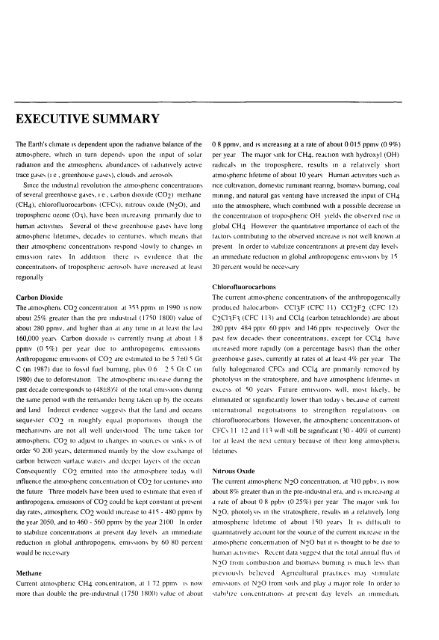First Assessment Report - IPCC
First Assessment Report - IPCC
First Assessment Report - IPCC
You also want an ePaper? Increase the reach of your titles
YUMPU automatically turns print PDFs into web optimized ePapers that Google loves.
EXECUTIVE SUMMARY<br />
The Earth's climate is dependent upon the radiative balance of the<br />
atmosphere, which in turn depends upon the input of solar<br />
radiation and the atmospheric abundances ot ladiatively active<br />
trace gases (1 e , greenhouse gases), clouds and aerosols<br />
Since the industrial revolution the atmospheric concentrations<br />
of several greenhouse gases, i e , carbon dioxide (CO2) methane<br />
(CH4), chlorofluorocarbons (CFCs), nitrous oxide (N2O), and<br />
tropospheric ozone (O3), have been increasing primarily due to<br />
human activities Several ol these gieenhouse gases have long<br />
atmospheric lifetimes, decades to centuries, which means that<br />
their atmospheric concentrations respond slowly to changes in<br />
emission rates In addition theie is evidence that the<br />
concentrations of troposphenc aerosols have increased at least<br />
regionally<br />
Carbon Dioxide<br />
The atmospheric C02 concentration at'W ppm\ in 1990 is now<br />
about 25% greater than the pre industiial (1750 1800) value of<br />
about 280 ppmv, and higher than at any tune in at least the last<br />
160,000 years Carbon dioxide is currently rising at about 1 8<br />
ppmv (0 5%) per year due to anthropogenic emissions<br />
Anthropogenic emissions ol CCn are estimated to be 5 7±0 5 Gt<br />
C (in 1987) due to fossil fuel burning, plus 0 6 2 5 Gt C (in<br />
1980) due to deforestation The atmospheric inuease during the<br />
past decade corresponds to (48±8)% ol the total emissions during<br />
the same period with the remamdei being taken up by the oceans<br />
and land Indirect evidence suggests that the land and oceans<br />
sequester CO2 in roughly equal pioportions though the<br />
mechanisms are not all well undeistood The time taken lor<br />
atmospheric CO2 to adjust to changes in sources 01 sinks is ot<br />
order 50 200 years, determined mainly by the slow exchange of<br />
carbon between surface watcis and deepei layeis ot the ocean<br />
Consequently CO2 emitted into the atmosphere today will<br />
influence the atmospheric concentiation ot CO2 tor centuries into<br />
the future Three models have been used to estimate that even if<br />
anthropogenic emissions of CO2 could be kept constant at present<br />
day rates, atmospheric CO2 would increase to 415 - 480 ppmv by<br />
the year 2050, and to 460 - 560 ppmv by the year 2100 In order<br />
to stabilize concentrations at present day levels an immediate<br />
reduction in global anthropogenic emissions by 60 80 perceni<br />
would be necessary<br />
Methane<br />
Current atmospheric CH4 concentration, at 1 72 ppim is now<br />
more than double the pre-industnal (1750 1800) value ot about<br />
0 8 ppmv, and is increasing at a rate of about 0 015 ppmv (0 9%)<br />
per year The major sink for CH4, reaction with hydroxyl (OH)<br />
radicals in the troposphere, results in a relatively short<br />
atmospheric lifetime of about 10 years Human activities such as<br />
rice cultivation, domestic ruminant rearing, biomass burning, coal<br />
mining, and natural gas venting have increased the input of CH4<br />
into the atmosphere, which combined with a possible decrease in<br />
the concentration ot tropospheric OH yields the observed rise in<br />
global CH4 However the quantitative importance of each ot the<br />
factors contributing to the observed increase is not well known at<br />
present In order to stabilize concentrations at present day levels<br />
an immediate reduction in global anthropogenic emissions by 15<br />
20 percent would be necessary<br />
Chlorofluorocarbons<br />
The current atmospheric concentrations of the anthropogenically<br />
produced halocarbons CCI3F (CFC 11) CCI2F2 (CFC 12)<br />
C2CI1F3 (CFC 1H) and CCI4 (carbon tetrachloride) are about<br />
280 pptv 484 pptv 60 pptv and 146 pptv respectively Over the<br />
past few decades their concentrations, except tor CCI4 have<br />
increased more rapidly (on a percentage basis) than the other<br />
gieenhouse gases, currently at rates ot at least 4% per year The<br />
fully halogenated CFCs and CCI4 are primarily removed by<br />
photolysis in the stratosphere, and have atmospheric lifetimes in<br />
excess of 50 years Future emissions will, most likely, be<br />
eliminated or significantly lower than todays because of current<br />
international negotiations to strengthen regulations on<br />
chlorofluorocarbons However, the atmospheric concentrations ot<br />
CFCs 11 12 and 1 H will still be significant O0 - 40% ot current)<br />
lor at least the next centuiy because ol their long atmosphenc<br />
lifetimes<br />
Nitrous Oxide<br />
The current atmospheric N2O concentration, at ^ 10 ppbv, is now<br />
about 8% greater than in the pre-industnal era, and is increasing al<br />
a rate of about 0 8 ppbv (0 25%) per year The major sink foi<br />
N2O, photolysis in the stratosphere, results in a relatively long<br />
atmospheric lifetime ot about 150 years It is difficult to<br />
quantitatively account tor the source of the current increase in the<br />
atmospheric concentiation of N2O but it is thought to be due to<br />
human activities Recent data suggest thai the total annual flu\ ot<br />
N2O from combustion and biomass burning is much less than<br />
pieviously believed Agricultural practices may stimulate<br />
emissions ot N2O from soils and play a major role In order to<br />
stabi'ize concentrations at present day levels an immediate
















